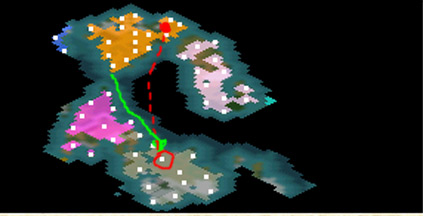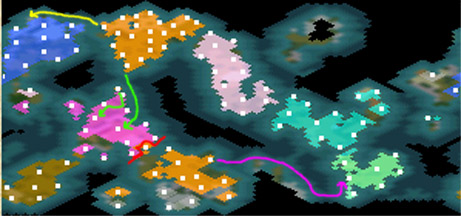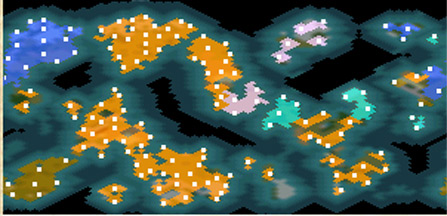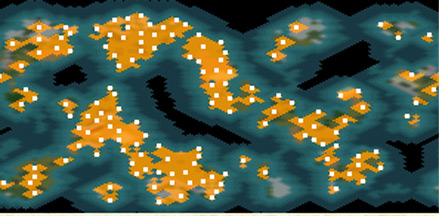1.27
Link to the
Ancient Age
This wasnt quite as good a game as the last few for me (I made several mistakes, a few of which can be seen in the thread after my ancient age post), but it was still a very good game for me overall. I was going for my first ever conquest victory.
My forbidden palace had been completed in the homeland before the end of the QSC, so I was looking for a place to establish my second core. Around 750bc, I traded maps with India, France and China. India had by far the best territory of the three, and they were also the strongest civ. Their land looked like it would make a very strong second core. I decided to try something new for me: rather than attacking a nearby civ, I decided to go after far-away India. I didnt know if I could make such a strategy pay off, because it takes so much longer to get to the opponent, but I decided to give it a shot.
I acquired the maps of the other civs in the next few turns, and I should have changed my strategy given the new information (Germany looked like a great target and America had three luxuries), but I stuck with my initial plan. France also completed the pyramids, but still I didnt switch goals, which was just silly. I think I got hard-headed. In 610bc, I gave literature to France and India, and both civs obediently started the Great Library in their capitols. That would be at least two cities that couldnt produce military to fight me. I got France to declare war on India the following turn, and in 570bc my boats departed with four settlers, a horse, an archer and 14 swordsmen. While they were en route, I discovered Republic and drew a seven-turn anarchy

Re-rolling yielded no improvement.
When I landed on Indian soil it was an unmitigated disaster. Apparently, my evil plan to sick the French on India did not work at all because they had swordsmen all over the freakin place. By the time I reached their capitol, I had eight swords left. After the attack, I had four (two redlined). Fortunately, I did get a great leader. I added my settlers to Madras, moved in my horse, archer and two swords, and then jumped my capitol to Indian Territory. I then used the Great Leader to rush the Great Library in the city. Unfortunately, because of the long anarchy, I was not able to produce the settler(s) to re-colonize the rich land left open when I abandoned my palace. It would have to wait a few turns.
Unfortunately, this far-away war left me in quite a bad spot. I had a new palace, but I was surrounded by hostile forces and had no way to defend myself. There was also no way my navy could get back home, load up, and return in time to protect the city. So, I saved the game and stopped to ponder the situation. Finally, I came up with a solution. In the next two turns, I packed almost all my military (about 20 mixed horses and swords) into a tiny city on my island, and then I gifted it to the Spanish. Of course, all the units inside jumped back to the palace, as they always do.

Its just that in this case my palace was on the other side of the world. Problem solved. I then declared war on Spain and reclaimed my city (but with a Spanish resistor now). The stunningly artistic green line on the map below shows my tedious boat trip, and the red line shows the Time-Warp trip of my second military force.
Now that I had the units, I could take out India. I was also in a big hurry to get a harbor built, so that I could trade Republic to the other civs for their luxuries
It was not until I rushed a harbor in 210bc that I realized the magnitude of my folly: I had jumped my palace to a continent that was separated from the rest of the world by a thin line of sea squares. I was going to be luxury deprived until I could either get Astronomy or take the Great Lighthouse from Spain. In short, establishing my second core in India had been a very, very bad idea.
I researched currency and entered the MAs in 50bc. I then planned my next big wars: with France (for the pyramids) and Spain (for the Great Lighthouse). Unfortunately, now I was in the position of needing to transport my military to the other side of the world
again. I had about 18 galleys at this time though, so it was doable. Spain also had tons of culture, so I knew flipping was going to be a problem. In the map below, the green lines show my plans for france (I control the city at the northern tip of the continent), the red line shows a force of attackers that are only there to keep france from taking my indan cities, purple is the horribly long boat trip to Madrid, and the yellow line was a gem-stealing mission. The gem mission was successful for only a very short time, because the city flipped to the Germans (in spite of my rushing a library and a temple). It had only a .18 chance of flipping, but I guess that was enough.
It took me until 310ad to finally take the pyramids, because the French proved to be much tougher than I expected (and, of course, I had sent a great portion of my military on the great sea voyage to Spain). In 380ad the French were off the main continent, and in 440 they were destroyed.
Meanwhile, the Great Voyage to Spain wasn't going too well either. A force of barb galleys attacked them when they were about 3 turns away from the Spanish capitol, and they sunk 3 of my galleys, fully loaded with Medieval Infantry. I then had to find more troops to send, and my navy had to wait for the reinforcements to catch up. Therefore, I didnt get the Lighthouse (Madrid) until 320adthe same turn I got Chivalry from the Great Library (I had turned research off after discovering Currency). In the turns that followed, I lost track of the number of times that city flipped. This, of course, forced me to wait before establishing any luxury deals. They would just have to wait until the Spanish were destroyed. That took until 510ad, and at that point I was ready to take the luxuries by force, so I didnt want to trade anymore.

In 370ad, I upgraded many of my horsemen to knights, and declared war on the Chinese. Two turns later I took their capitol, although that city would flip many times as well.
The rest of the game was just a big, long, tedious bloodbath, so I will not go into details. Because I fell behind militarily early on in the game, I ended up agonizing over the movements of each unit. I was not able to break this cycle, and I always lacked sufficient force to take out an enemy until the last 15 turns of the game. This, combined with all the culture flips, led to a very long game.
In 550ad, I completed Leonardo, which kicked off my GA (because I owned the Lighthouse). I realized that I would need cavalry to finish off the game quickly, so I cranked up research and had Mil. Trad. in 660ad. Then the game pace picked up.
Minimap at 660AD:
In 620 I re-declared war on India and took her last city.
In 700ad the Chinese were knocked off their mainland.
In 560 I declared on the Americans, and in 710 they were eliminated.
In 730 I declare on Germany and Russia, and in 780 they both become boat people. I found the Germans one turn later, but didnt get the Russians until 800ad.
Final conquest in 810ad, Jason score a hair over 10k. If anyone loads up my game, the ridiculous number of caravels was due to my rushing them in the last several turns of the game. I knew I was going to have trouble with boat people, and that is exactly what happened.

Minimap at 810AD:
Final Thoughts: I think the strategy of attacking a far-off civ could pay off (in classic GOTM, not COTM), but it would take a very special map situation. On this particular map, it would have been a good strategy if everything had remained the same, except that India had three luxuries instead of America. Too bad I didnt realize that when I decided to attack them!



 Re-rolling yielded no improvement.
Re-rolling yielded no improvement. Its just that in this case my palace was on the other side of the world. Problem solved. I then declared war on Spain and reclaimed my city (but with a Spanish resistor now). The stunningly artistic green line on the map below shows my tedious boat trip, and the red line shows the Time-Warp trip of my second military force.
Its just that in this case my palace was on the other side of the world. Problem solved. I then declared war on Spain and reclaimed my city (but with a Spanish resistor now). The stunningly artistic green line on the map below shows my tedious boat trip, and the red line shows the Time-Warp trip of my second military force.




